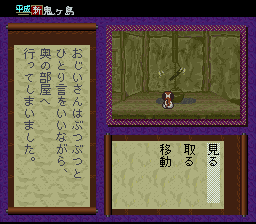Retro Replay Review
Gameplay
Heisei Shin Onigashima: Zenpen offers a classic menu-driven adventure system, where you navigate through environments and interact with the world by choosing commands like “Look,” “Take,” and “Talk.” Beyond these staples, each chapter introduces unique action verbs—such as “Smell” during Ringo’s segment—that leverage the animal’s special senses. This contextual approach keeps exploration fresh and encourages experimentation with different commands in every new area.
The game is split into two large chapters. In the first, you assume the perspective of the dog Ringo, using keen canine instincts to sniff out hidden clues. The second chapter shifts to Matsunosuke the monkey, who can climb, swing, and manipulate objects in ways Momotaro cannot. This dual-protagonist structure adds depth, as each companion brings its own movement and puzzle-solving mechanics to the journey.
Puzzle difficulty is balanced—early obstacles teach command usage, while later challenges require combining actions in creative ways. Hints are embedded in dialogue and environmental details rather than in a separate hint menu, rewarding players who pay close attention. Occasional node-based movement segments allow physical navigation, breaking up menu interaction and giving a sense of spatial traversal.
The streamlined interface limits busywork and focuses on story-driven discovery. While movement points are fixed, each location is rich with interactive elements that reward thorough exploration. Fans of point-and-click adventures will appreciate the game’s deliberate pacing and thoughtful puzzle loops.
Graphics
The visual presentation of Zenpen channels early 16-bit charm, with colorful pixel art that captures the essence of traditional Japanese folklore. Character sprites are expressive, featuring enough animation frames to convey emotion without cluttering the screen. Ringo’s tail wags, Matsunosuke’s agile leaps, and Momotaro’s determined gaze all feel lively and endearing.
Backgrounds boast lush environments—from dense bamboo forests and tranquil villages to the eerie interiors of ogre lairs. Each scene is layered with subtle parallax scrolling and occasional ambient animations, such as fluttering leaves or dancing lantern light, which enrich the world without overwhelming the retro aesthetic.
Transition sequences and illustrated cutscenes employ a watercolor-inspired art style, blending brush-stroke textures with crisp linework. These interludes heighten narrative moments, giving the game a storybook quality that aligns perfectly with its fairy-tale roots.
While resolution and color depth may feel modest by modern standards, the cohesive art direction ensures clarity and atmosphere throughout. The UI design remains clean and unobtrusive, allowing you to focus on both the puzzles and the picturesque world.
Story
Based on the beloved Japanese folk tale of Momotaro—the “Peach Boy” born from a giant fruit—Zenpen retells the classic narrative through the eyes of its animal companions. The first chapter centers on Ringo, the devoted dog, whose loyalty and keen senses drive early plot revelations. In the second, Matsunosuke the monkey takes the stage, using wit and agility to unravel new mysteries on the path to the ogres’ island.
The script strikes a balance between faithfulness and expansion, preserving the folkloric backbone while adding emotional layers to secondary characters. Conversations reveal backstory, showcase each companion’s personality, and hint at motivations that deepen engagement. Momotaro himself remains a guiding presence, but it’s the animals who shine as relatable protagonists.
Dialogue is crisply localized, retaining cultural nuance through period-appropriate expressions and occasional Japanese terms. Narrative pacing is steady: the early sections allow players to acclimate to mechanics and folklore, while the latter half subtly raises the stakes as Matsunosuke’s trials grow more complex.
By structuring the journey into two distinct yet interconnected chapters, Zenpen sets the stage for the sequel (“Kouhen”) and leaves players eager to see how Momotaro’s quest concludes. The storytelling is anchored by heartfelt moments of friendship, bravery, and the promise of thrilling confrontations with the ogre tribe.
Overall Experience
Heisei Shin Onigashima: Zenpen is a delightful blend of classic adventure gameplay, charming pixel art, and timeless storytelling. Its menu-based interaction may feel nostalgic to veteran players and offers an approachable entry point for newcomers. The specialized commands for Ringo and Matsunosuke inject novelty into each chapter, preventing the experience from growing stale.
Though the pace leans toward the leisurely side—typical of early ’90s adventure titles—the game’s well-crafted puzzles and narrative rewards ensure that curiosity remains high. There’s no hand-holding, but environmental cues and character dialogue provide subtle guidance, making each “aha” moment deeply satisfying.
If you’re fascinated by Japanese folklore or enjoy story-rich puzzle adventures, Zenpen delivers on both fronts. Its art and sound design evoke the atmosphere of an ancient fairy tale, while its dual-perspective structure brings fresh mechanics to familiar storytelling.
Completing Zenpen’s opening chapters leaves you eager for the concluding installment, promising that the full saga of Momotaro and his companions will be just as memorable. For anyone seeking a thoughtfully crafted retro adventure with heart and tradition, Heisei Shin Onigashima: Zenpen is a highly recommended journey.
 Retro Replay Retro Replay gaming reviews, news, emulation, geek stuff and more!
Retro Replay Retro Replay gaming reviews, news, emulation, geek stuff and more!









Reviews
There are no reviews yet.